Cash
Through a current account
Electronic card (Visa, Master, Dina, etc.)
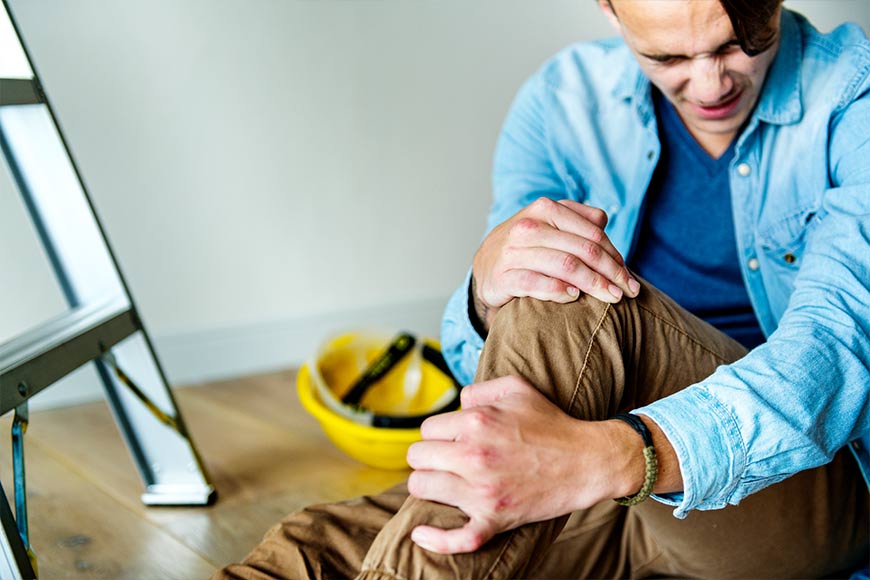
Fokus Fizical 100% guarantees fast and effective healing
Super DISCOUNT! 20% on all therapies in Oktober!
Do not treat yourself over the Internet! Make an appointment via Viber now
The front of the knee, or the region in front of and below the patella (kneecap), is a common site of pain due to a variety of mechanical and functional disorders. This part of the knee plays a key role in everyday movements – from standing up, walking, and climbing stairs, to squatting and physical activities such as running, jumping, or kneeling. Due to its anatomical position and high mobility, it is often exposed to overload, especially if there is an imbalance in the muscles of the upper leg, poor movement biomechanics, or weakness in the joint stabilizers.
Pain in the front of the knee is most often associated with a disorder in the movement of the patella within the groove of the femur. When the kneecap does not slide properly – due to improper force distribution, weakness of the quadriceps, or changes in gait – friction, inflammation, and possible damage to the cartilage under the kneecap occur. In addition, frequent use of this part of the joint, especially in athletes and physically active people, can lead to inflammation of the tendons (tendinitis), irritation of the mucous bags (bursitis) or the development of chronic problems such as chondromalacia patella.
This pain does not only occur in athletes – it is also increasingly common in people who sit for long periods of time (e.g. at a computer or in a car), as well as in those with poor posture, flat feet or unstable hips. Therefore, it is important to recognize the cause and seek treatment in a timely manner to avoid chronic damage and reduced knee functionality.
Pain in the front of the knee can manifest in a number of ways, and symptoms can develop gradually or suddenly, depending on the cause and the load the knee is exposed to. This type of pain is often not constant – it occurs and worsens with certain situations that involve bending the knee, sitting for a long time, physical activity or carrying a load. In some people, the symptoms are mild and intermittent, while in others they can be intense and limit everyday movements, even walking. Understanding the symptoms can help identify the problem early and prevent further deterioration of the condition.
The most common symptoms include:
These symptoms may not all be present at the same time, but if any of them occur regularly or worsen over time, professional diagnosis is recommended. Early intervention can prevent the development of chronic problems and long-term mobility problems.
Pain in the front of the knee can have many different causes, and is most often the result of mechanical irregularities in the movements of the knee joint or excessive strain on certain structures. The knee joint is very complex, and its stability depends on the proper functioning of bones, cartilage, ligaments, tendons and muscles. When one part of this system does not function properly - whether due to injury, muscle weakness, inflammation or degeneration - pain occurs, especially in the front of the knee. The most common causes of this problem are described below:
Patellofemoral pain syndrome (runner's knee): Patellofemoral syndrome is one of the most common causes of pain in the front of the knee. It occurs when the kneecap (patella) does not slide properly within the groove of the thigh bone (femur), which leads to increased friction and irritation of the tissues under and around the kneecap. This can be due to weakness of the quadriceps muscles, poor pelvic position, flat feet or inadequate movement technique. It most commonly occurs in runners, cyclists, recreational athletes who put excessive strain on their knees, and people who frequently kneel or squat. The pain is usually dull, localized around the kneecap, and worsens when going down stairs, squatting, or sitting for long periods of time.
Patellar tendonitis (jumper's knee): This condition is an inflammation or overuse of the tendon that connects the lower part of the kneecap to the lower leg (tibia), known as the patellar tendon. It most commonly occurs in athletes who frequently jump, sprint, or change direction quickly—such as basketball, volleyball, and soccer players. Tendinitis causes localized pain under the kneecap, especially during and after physical activity. If left untreated, it can become chronic and lead to weakening of the tendon, which increases the risk of injury.
Chondromalacia patella: Pain in the front of the knee can have a number of different causes, and is most often the result of mechanical irregularities in the movements of the knee joint or excessive strain on certain structures. The knee joint is very complex, and its stability depends on the proper functioning of bones, cartilage, ligaments, tendons and muscles. When one part of this system does not function properly – whether due to injury, muscle weakness, inflammation or degeneration – pain occurs, especially in the front of the knee. The most common causes of this problem are described below:
Weakness or imbalance of the quadriceps muscles: The quadriceps is the main muscle of the upper leg and plays a key role in stabilizing the kneecap during movement. When this muscle is weakened – whether due to inactivity, injury or poor posture – uneven traction of the kneecap occurs, resulting in abnormal sliding and increased pressure on the joint. It is especially important to emphasize the role of the inner part of the quadriceps (vastus medialis obliquus), which is often weaker than the outer part, which leads to lateral displacement of the patella. This condition can develop gradually and is often the main cause of chronic discomfort in the front of the knee.
Other factors (optional, but useful to add): In addition to the above conditions, the appearance of pain in the front of the knee can also be influenced by:
If the cause is not discovered in time, the pain can become chronic and cause permanent changes in the joint. Therefore, it is important to pay attention to the first signs of discomfort, correct daily habits and seek professional advice.
Treatment for anterior knee pain depends on the exact cause, the severity of the symptoms, the duration of the problem, and the patient’s overall health. In most cases, the approach is nonoperative (conservative) and focuses on relieving pain, reducing inflammation, and correcting the biomechanical factors that contributed to the problem. The goal of treatment is to gradually return the patient to normal, pain-free activities while improving knee stability and function.
The most common and effective methods used in treatment are described below:
Rest and Avoidance of Aggravating Activities: The first step in treatment is to reduce the load on the knee and temporarily avoid activities that cause pain, such as squatting, climbing stairs, jumping, or running uphill. Temporary rest does not mean complete cessation of movement, but rather a smart dosage of activities that do not irritate the joint.
Application of ice (cryotherapy): Ice helps relieve pain and reduce local inflammation. It is recommended to apply cold compresses or gel packs to the painful area for 15–20 minutes, several times a day, especially after activity. Ice should not be applied directly to the skin, but wrapped in a towel or protective cloth.
Physiotherapy – the key to recovery: Physiotherapy is central to the treatment of anterior knee pain because it works on the cause of the problem, not just the symptoms. Exercises focus on:
A physiotherapist may also use additional methods such as electrotherapy, ultrasound, manual therapy and education on proper gait and posture.
Stretching and mobility exercises: Shortening of the hamstring, quadriceps, calf and hip flexor muscles can contribute to improper movement of the kneecap. Regular stretching of these muscle groups contributes to better knee mechanics and relieves the front of the joint. These exercises should be done daily and under the supervision of a specialist in the initial phase.
Use of orthoses and patellar stabilization tapes: In people with severe patellar instability or chronic patellofemoral syndrome, special orthoses or kinesio tapes can help to guide the patella during movement and reduce friction. Tapes are especially used by athletes during activity.
Pain and inflammation medications (as recommended by a doctor): Nonsteroidal anti-inflammatory drugs (NSAIDs), such as ibuprofen or diclofenac, can help control pain and inflammation, especially in the early stages. However, they are not recommended for long-term use without medical supervision, as they can cause side effects.
Injection therapies: In more severe cases where pain does not go away with conventional methods, your doctor may suggest:
Surgical treatment (in exceptional cases): If none of the previous methods bring relief, and the patient has severe cartilage damage, chronic patellar instability or other structural changes, the doctor may recommend arthroscopic surgery. This procedure is used to remove damaged cartilage, smooth the surfaces or stabilize the patella.
The success of treatment depends on the correct diagnosis and consistent application of therapy. Most patients recover completely with a combination of physical therapy, correction of daily habits and muscle strengthening. It is crucial that treatment is individualized and carried out under the supervision of a specialist, in order to prevent the return of pain and damage to the joint in the long term.
Why does my knee hurt in the front?
The most common causes of pain in the front of the knee are patellofemoral syndrome (runner's knee), patellar tendonitis (jumper's knee), quadriceps weakness, or damage to the cartilage under the kneecap (chondromalacia). These problems are caused by improper movement of the kneecap, overuse, weak muscles, or poor movement mechanics.
When should I see a doctor about this pain?
If the pain lasts longer than a few days, increases with daily activities (walking, squatting, stairs), swelling, instability, or creaking in the knee occurs - a visit to an orthopedist or physiatrist is recommended for an accurate diagnosis and treatment plan.
Does exercise make front knee pain worse?
Some exercises can worsen the condition if they put additional strain on the knee (e.g. deep squats, jumping), but properly selected exercises – with professional guidance – can strengthen the muscles and reduce pain. Exercise should not be avoided completely, but adjusted.
Is ice effective for this type of pain?
Yes, applying ice several times a day helps reduce inflammation and pain, especially after activity. Ice should be applied for 15–20 minutes over a cloth, and should not be used directly on the skin.
Can anterior knee pain return after treatment?
Unfortunately, yes – if the causes such as muscle weakness, poor posture or improper knee loading are not addressed. That's why it's important to continue with the recommended exercises, wear appropriate footwear and pay attention to movement and training technique.
Cash
Through a current account
Electronic card (Visa, Master, Dina, etc.)
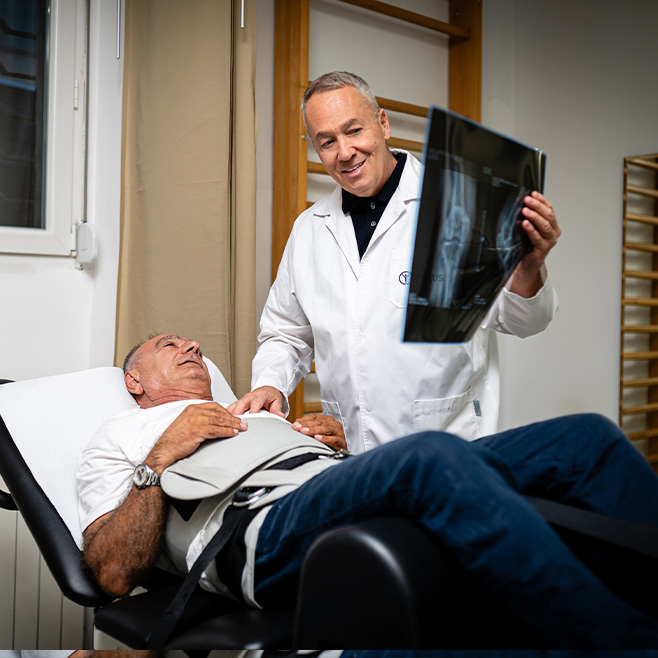
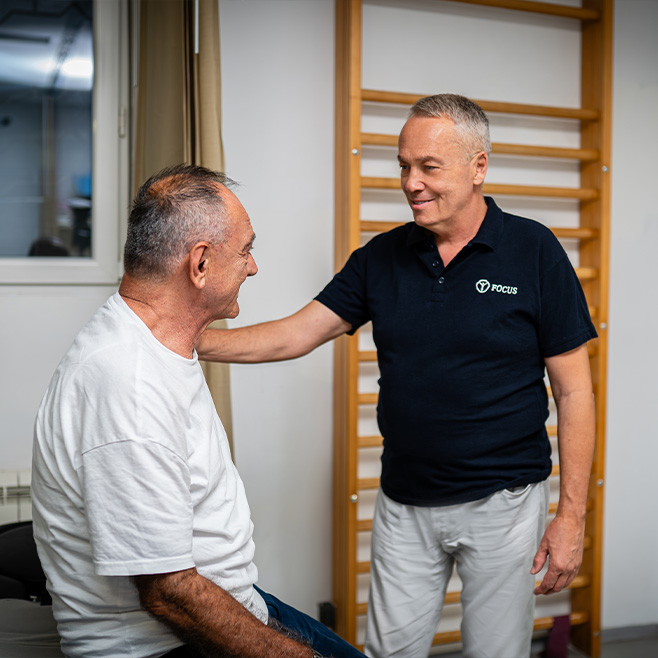
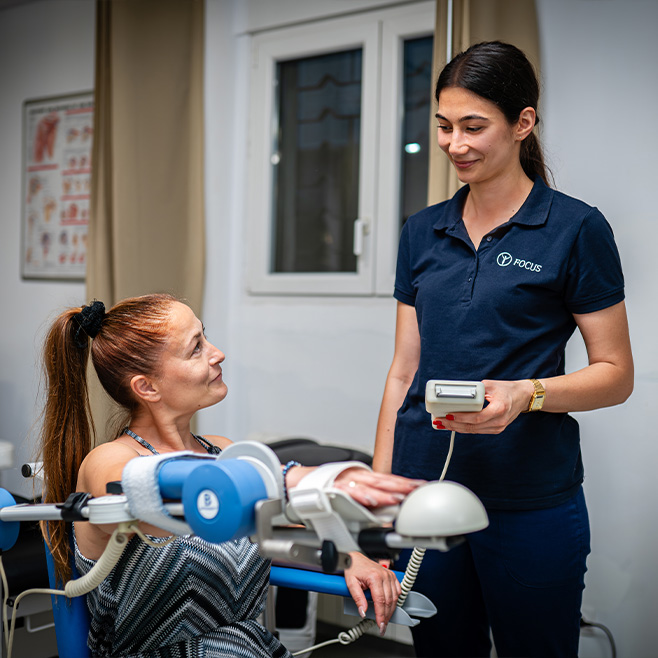
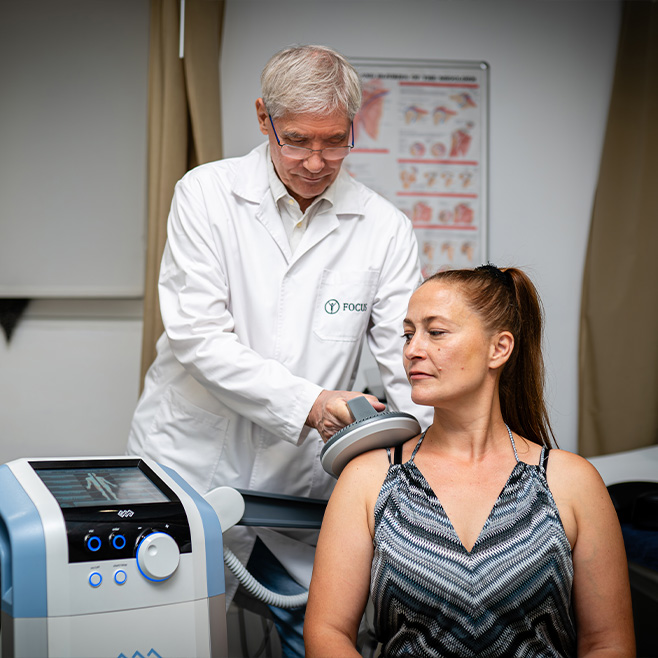
See the experiences of our satisfied patients who successfully recovered with the help of our physical therapy. Get acquainted with the testimonies of patients who faced various joint injuries, sports knee injuries, back injuries and similar problems, which we quickly, efficiently and successfully treated.
Aesthetic surgery
Focus Fizikal is a leading private clinic for physical therapy in Belgrade. For more than 10 years, we have been providing high-quality services that enable quick recovery and healing of our patients.

For all our current and future patients, we have made it possible to schedule an appointment online.